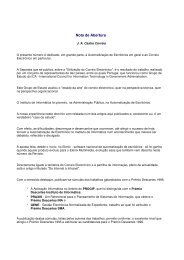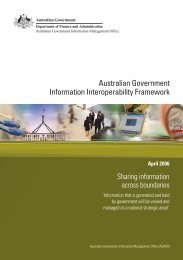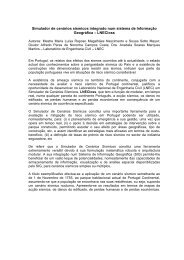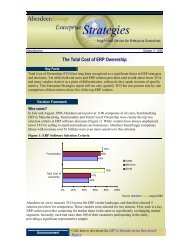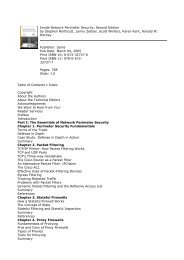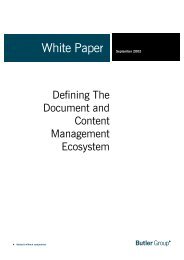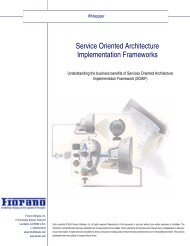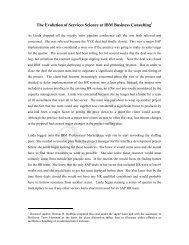OECD Peer Review of E-Government in Denmark - ePractice.eu
OECD Peer Review of E-Government in Denmark - ePractice.eu
OECD Peer Review of E-Government in Denmark - ePractice.eu
Create successful ePaper yourself
Turn your PDF publications into a flip-book with our unique Google optimized e-Paper software.
V. ORGANISATIONAL CHANGE<br />
This chapter looks at the impact e-government is hav<strong>in</strong>g on organisational change <strong>in</strong> Danish<br />
government, at both the all-<strong>of</strong>-government and the <strong>in</strong>dividual organisation levels. At the<br />
all-<strong>of</strong>-government level, the relationship between e-government and the current Structural Reform is<br />
exam<strong>in</strong>ed. The chapter also looks at four key dimensions <strong>of</strong> how e-government affects organisational<br />
change with<strong>in</strong> <strong>in</strong>dividual organisations, namely: 1) <strong>in</strong>formation and knowledge shar<strong>in</strong>g; 2)<br />
organisational structure; 3) organisational processes; and 4) organisational values and culture. It also<br />
looks at the impact <strong>of</strong> e-government and ICT on organisational skills, with a focus on assess<strong>in</strong>g<br />
organisations’ progress to date <strong>in</strong> develop<strong>in</strong>g and ma<strong>in</strong>ta<strong>in</strong><strong>in</strong>g the skills e-government requires.<br />
E-government and the Structural Reform<br />
The decentralised structure <strong>of</strong> the Danish public sector sets the <strong>in</strong>stitutional context for the<br />
implementation <strong>of</strong> e-government. Dur<strong>in</strong>g the past 30 years, adm<strong>in</strong>istrative power and policy<br />
responsibility have <strong>in</strong>creas<strong>in</strong>gly been transferred from State to local government, creat<strong>in</strong>g highly<br />
autonomous local government which is responsible for delivery <strong>of</strong> many government services. The<br />
result<strong>in</strong>g closeness <strong>of</strong> local authorities to the users <strong>of</strong> their services provides a helpful environment for<br />
electronic delivery <strong>of</strong> user-focused public services.<br />
The <strong>in</strong>stitutional context for e-government <strong>in</strong> <strong>Denmark</strong> is currently undergo<strong>in</strong>g major change.<br />
Although a nationally co-ord<strong>in</strong>ated restructur<strong>in</strong>g <strong>of</strong> government based explicitly on e-government<br />
ideas has never been contemplated, the large-scale Structural Reform (“the Reform”) <strong>of</strong> the public<br />
sector that is underway will likely be the dom<strong>in</strong>ant feature <strong>of</strong> the Danish public management<br />
environment for at least the next three years. The Reform is not directly motivated by e-government,<br />
but is driven by an economic goal <strong>of</strong> <strong>in</strong>creas<strong>in</strong>g the efficiency and competitiveness <strong>of</strong> local<br />
government, coupled with goals <strong>of</strong> mak<strong>in</strong>g government more open, responsive, effective and<br />
participatory (details <strong>of</strong> the Reform are provided <strong>in</strong> Appendix 2).<br />
While e-government is neither an explicit driver nor a goal <strong>of</strong> the Reform, it is clearly an enabler<br />
<strong>of</strong> the reform process. It is also central to achievement <strong>of</strong> some <strong>of</strong> its key objectives, such as<br />
reorganisation <strong>of</strong> the health sector and creation <strong>of</strong> “local service centres” that will become the primary<br />
<strong>of</strong>fl<strong>in</strong>e entry po<strong>in</strong>t for delivery <strong>of</strong> as many State and local government services as possible.<br />
The Reform appears to be heavily <strong>in</strong>fluenced by the ideas <strong>in</strong>form<strong>in</strong>g the <strong>Government</strong>’s overall<br />
drive for public sector modernisation, <strong>of</strong> which e-government is a key component. The Citizens at the<br />
Wheel (2002) modernisation programme is develop<strong>in</strong>g approaches to public management that shift the<br />
focus <strong>of</strong> organisational change away from structural issues (such as the shape and size <strong>of</strong> organisations<br />
and allocation <strong>of</strong> their roles and responsibilities) to the actual nature and objectives <strong>of</strong> government<br />
policies and functions, and the way that organisations work separately and collectively to achieve<br />
them. It is based on the overarch<strong>in</strong>g pr<strong>in</strong>ciple that public services should be provided how and where<br />
they can achieve the best outcome for their users. With<strong>in</strong> this more citizen- or user-oriented<br />
framework, e-government can be a useful tool to enable and monitor change, improve governance<br />
arrangements and enhance collaboration across government <strong>in</strong> the provision <strong>of</strong> public services.<br />
Officials’ perceptions <strong>of</strong> the role and function <strong>of</strong> e-government <strong>in</strong> the process <strong>of</strong> the Structural<br />
Reform differ with<strong>in</strong> <strong>in</strong>dividual organisations. In extensive discussions <strong>of</strong> the Structural Reform held<br />
78



